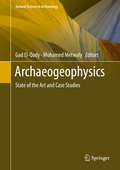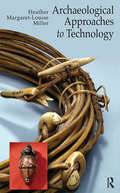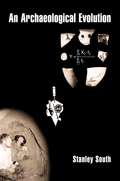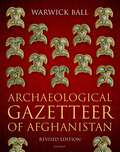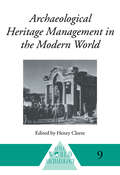- Table View
- List View
Archaeogaming: An Introduction to Archaeology in and of Video Games
by Andrew ReinhardVideo games exemplify contemporary material objects, resources, and spaces that people use to define their culture. Video games also serve as archaeological sites in the traditional sense as a place, in which evidence of past activity is preserved and has been, or may be, investigated using the discipline of archaeology, and which represents a part of the archaeological record. This book serves as a general introduction to "archaeogaming"; it describes the intersection of archaeology and video games and applies archaeological method and theory into understanding game-spaces as both site and artifact.
Archaeogeophysics: State of the Art and Case Studies (Natural Science in Archaeology)
by Gad El-Qady Mohamed MetwalyThis book describes the application of non-destructive geophysical methods in subsurface archaeological features. Such non-destructive methods are magnetometry, electrical resistance, electromagnetic conductivity, magnetic susceptibility and ground penetrating radar. This book also includes the last improvements in instrumentation, data processing, and interpretations of the collected data sets leading to the rapid progress in geophysical applications in the field of archaeological investigations. The book also provides complete case-studies and archaeological interpretation obtained our results carried out in different localities around the world.
Archaeological 3D GIS
by Nicolò Dell’Unto Giacomo LandeschiArchaeological 3D GIS provides archaeologists with a guide to explore and understand the unprecedented opportunities for collecting, visualising, and analysing archaeological datasets in three dimensions. With platforms allowing archaeologists to link, query, and analyse in a virtual, georeferenced space information collected by different specialists, the book highlights how it is possible to re-think aspects of theory and practice which relate to GIS. It explores which questions can be addressed in such a new environment and how they are going to impact the way we interpret the past. By using material from several international case studies such as Pompeii, Çatalhöyük, as well as prehistoric and protohistoric sites in Southern Scandinavia, this book discusses the use of the third dimension in support of archaeological practice. This book will be essential for researchers and scholars who focus on archaeology and spatial analysis, and is designed and structured to serve as a textbook for GIS and digital archaeology courses.
Archaeological 3D GIS
by Nicolò Dell’Unto Giacomo LandeschiArchaeological 3D GIS provides archaeologists with a guide to explore and understand the unprecedented opportunities for collecting, visualising, and analysing archaeological datasets in three dimensions. With platforms allowing archaeologists to link, query, and analyse in a virtual, georeferenced space information collected by different specialists, the book highlights how it is possible to re-think aspects of theory and practice which relate to GIS. It explores which questions can be addressed in such a new environment and how they are going to impact the way we interpret the past. By using material from several international case studies such as Pompeii, Çatalhöyük, as well as prehistoric and protohistoric sites in Southern Scandinavia, this book discusses the use of the third dimension in support of archaeological practice. This book will be essential for researchers and scholars who focus on archaeology and spatial analysis, and is designed and structured to serve as a textbook for GIS and digital archaeology courses.
Archaeological and Anthropological Perspectives on the Native Peoples of Pampa, Patagonia, and Tierra del Fuego to the Nineteenth Century (Native Peoples of the Americas)
by Claudia Briones José Luis LanataThe Spanish conquerors who explored the southern cone of South America reported back to Europe that the region was empty of human inhabitants. In truth, however, the large area supported a thriving, albeit low-density, population of foragers. Those foragers—the Mapuche, Tehuelche, Rankuelche, and Fueguian peoples—are the subject of this volume, which presents archaeological and ethnographic studies of their past.The southern cone of South America was one of the last regions to be colonized on earth. When the Spanish Royal Crown experienced difficulties expanding its colonial frontiers to include these lands, the area became known as a vast wildnerness at the very edge of the civilized world. As a result, the native peoples who did indeed inhabit the area were marginalized and as time passed the significance of their historical experience was ignored. This compilation of research by noted scholars of the region investigates the past of peoples largely neglected by the historical accounts of their conquerors. The history of the native peoples of Pampa, Patagonia, and Tierra del Fuego is a vital aspect of the region's past. Their historical knowledge and experience play a vital role in the struggle of a people to maintain a sense of cultural difference in an ever-changing world.
Archaeological and Paleontological Research in Lagoa Santa: The Quest for the First Americans
by Pedro Da-Gloria Walter A. Neves Mark HubbeThis groundbreaking volume presents, for the first time in English, a broad historical review of the researches carried out over 170 years in the region of Lagoa Santa, Brazil, one of the most important archaeological regions in the Americas. From the pioneering work of the Danish naturalist Peter Lund in the XIX century to the recent research on the dispersion of early humans across South America, led by Walter A. Neves and colleagues, Lagoa Santa has offered remarkable findings, the largest collections of early human skeletons in the Americas, and has contributed to the overall discussions about the settlement of the Americas. This edited volume aims to fill the lack of publications in English about Lagoa Santa and gathers representatives of all the main Brazilian institutions directly involved in the archaeological and paleontological investigations in the region, in order to provide the international scientific community a comprehensive and complete account of the researches that contributed to rewrite the history of the peopling of the Americas. The book is organized in two parts. The first consists of chapters describing each of the interventions in the region, beginning with the pioneering work of Peter Lund and culminating with the latest intervention led by Walter A. Neves and his team. The second part of the book consists of reviews of current relevant research foci in the region, such as migrations, health, mortuary rituals, paleontology, rock art and technology.
Archaeological Approaches to Cultural Identity (One World Archaeology)
by S. J. ShennanFirst published in 2003. Routledge is an imprint of Taylor & Francis, an informa company.
Archaeological Approaches to Cultural Identity (One World Archaeology)
by Stephen ShennanFirst published in 2003. Routledge is an imprint of Taylor & Francis, an informa company.
Archaeological Approaches to Market Exchange in Ancient Societies
by Christopher P. Garraty Barbara L. StarkAncient market activities are dynamic in the economies of most ancient states, yet they have received little research from the archaeological community. Archaeological Approaches to Market Exchange in Ancient Societies is the first book to address the development, change, and organizational complexity of ancient markets from a comparative archaeological perspective. Drawing from historical documents and archaeological records from Mesoamerica, the U.S. Southwest, East Africa, and the Andes, this volume reveals the complexity of ancient marketplace development and economic behavior both in hierarchical and non-hierarchical societies. Highlighting four principal themes-the defining characteristics of market exchange; the recognition of market exchange archaeologically; the relationship among market, political, and other social institutions; and the conditions in which market systems develop and change-the book contains a strong methodological and theoretical focus on market exchange. Diverse contributions from noted scholars show the history of market exchange and other activities to be more dynamic than scholars previously appreciated. Archaeological Approaches to Market Exchange in Ancient Societies will be of interest to archaeologists, anthropologists, material-culture theorists, economists, and historians.
Archaeological Approaches to Technology
by Heather Margaret-Louise MillerThis book is designed for upper-division undergraduate and graduate level archaeology students taking courses in ancient technologies, archaeological craft production, material culture, the history of technology, archaeometry, and field methods. This text can also serve as a general introduction and a reference for archaeologists, material culture specialists in socio-cultural disciplines, and engineers/scientists interested in the backgrounds and histories of their disciplines. The study of ancient technologies, that is, the ways in which objects and materials were made and used can reveal insights into economic, social, political, and ritual realms of the past. This book summarizes the current state of ancient technology studies by emphasizing methodologies, some major technologies, and the questions and issues that drive archaeologists in their consideration of these technologies. It shows the ways that technology studies can be used by archaeologists working anywhere, on any type of society and it embraces an orientation toward the practical, not the philosophical. It compares the range of pre-industrial technologies, from stone tool production, fiber crafts, wood and bone working, fired clay crafts, metal production, and glass manufacture. It includes socially contextualized case studies, as well as general descriptions of technological processes. It discusses essential terminology (technology, material culture, chaine operatoire, etc.), primarily from the perspective of how these terms are used by archaeologists.
Archaeological Approaches to Technology
by Heather Margaret-Louise MillerThis book is designed for upper-division undergraduate and graduate level archaeology students taking courses in ancient technologies, archaeological craft production, material culture, the history of technology, archaeometry, and field methods. This text can also serve as a general introduction and a reference for archaeologists, material culture specialists in socio-cultural disciplines, and engineers/scientists interested in the backgrounds and histories of their disciplines. The study of ancient technologies, that is, the ways in which objects and materials were made and used can reveal insights into economic, social, political, and ritual realms of the past. This book summarizes the current state of ancient technology studies by emphasizing methodologies, some major technologies, and the questions and issues that drive archaeologists in their consideration of these technologies. It shows the ways that technology studies can be used by archaeologists working anywhere, on any type of society and it embraces an orientation toward the practical, not the philosophical. It compares the range of pre-industrial technologies, from stone tool production, fiber crafts, wood and bone working, fired clay crafts, metal production, and glass manufacture. It includes socially contextualized case studies, as well as general descriptions of technological processes. It discusses essential terminology (technology, material culture, chaine operatoire, etc.), primarily from the perspective of how these terms are used by archaeologists.
Archaeological Artefacts as Material Culture
by Linda HurcombeThis book is an introduction to the study of artefacts, setting them in a social context rather than using a purely scientific approach. Drawing on a range of different cultures and extensively illustrated, Archaeological Artefacts and Material Culture covers everything from recovery strategies and recording procedures to interpretation through typology, ethnography and experiment, and every type of material including wood, fibers, bones, hides and adhesives, stone, clay, and metals. With over seventy illustrations with almost fifty in full colour, this book not only provides the tools an archaeologist will need to interpret past societies from their artefacts, but also a keen appreciation of the beauty and tactility involved in working with these fascinating objects. This is a book no archaeologist should be without, but it will also appeal to anybody interested in the interaction between people and objects.
Archaeological Artefacts as Material Culture
by Linda HurcombeThis book is an introduction to the study of artefacts, setting them in a social context rather than using a purely scientific approach. Drawing on a range of different cultures and extensively illustrated, Archaeological Artefacts and Material Culture covers everything from recovery strategies and recording procedures to interpretation through typology, ethnography and experiment, and every type of material including wood, fibers, bones, hides and adhesives, stone, clay, and metals. With over seventy illustrations with almost fifty in full colour, this book not only provides the tools an archaeologist will need to interpret past societies from their artefacts, but also a keen appreciation of the beauty and tactility involved in working with these fascinating objects. This is a book no archaeologist should be without, but it will also appeal to anybody interested in the interaction between people and objects.
Archaeological Ceramic Materials: Origin and Utilization (Natural Science in Archaeology)
by Bruce Velde Isabelle C. DrucThe text which follows is based largely on the personal experience of the authors. The examples used which concern archaeological material, thin sections of sherds and many of the case studies are for the most part those which we have developed ourselves. This experience. may seem biased when one thinks of the large experience of petrographic archaeology, and this is surely true, but it is a reflection of our observations which are more complete for the objectives we have in mind than most of the examples given in the literature. For example, we have access to initial sherds, photo graphs, grain-size measurements and so forth for the same materials and we can present a specific archaeological context and problem using these data. Of course, there have been many studies on the same general subjects published elsewhere. As it turns out, our collective experience covers two of the major fields of investigation, the old (European) world and the new (American) one. It is evident that the problems are different in these two worlds. The contexts of production, distribution and use are different. The evolution of tech niques is very different although covering similar time periods. These two view points are complementary and, we hope, will enrich the investigative methods and outlook of workers in both cultural areas.
Archaeological Dimension of World Heritage: From Prevention to Social Implications (SpringerBriefs in Archaeology)
by Alicia CastilloThis volume presents case studies from around the world aiming to serve as a hands-on book for management and treatment of archaeological World Heritage properties. It comprises not only sites inscribed as World Heritage due to their archaeological character but also World Heritage properties where the analysis of their archaeological dimension provides a deeper and better understanding of the assets and includes the potential for disseminating this knowledge. The book has an important practical value, since all the works presented here illustrate - with practical examples, the best and most appropriate ways to manage World Heritage properties. The aim of the heritage managers at these World Heritage sites is to improve conservation and increase understanding and communication in such a way that the communities living in those sites or who earn a livelihood from them can be positively affected by these initiatives.The book presents exemplary models of heritage management in World Heritage properties–an issue not treated in depth up to now and Best Practices in this management. Therefore, this volume becomes a new, original source presenting model strategies to be followed by other initiatives in order to improve the consideration and treatment of the most outstanding valued sites considered by UNESCO.
Archaeological Displays and the Public: Museology and Interpretation, Second Edition (UCL Institute of Archaeology Publications)
by Paulette M. McManusThis volume is a set of a dozen case studies of innovative programs designed to attract the public to both archaeological sites and exhibits of archaeological artifacts. Papers deal with general issues of interpretation and presentation and cover British, Australian, European, and American settings.
Archaeological Displays and the Public: Museology and Interpretation, Second Edition (UCL Institute of Archaeology Publications)
by Paulette M. McManusThis volume is a set of a dozen case studies of innovative programs designed to attract the public to both archaeological sites and exhibits of archaeological artifacts. Papers deal with general issues of interpretation and presentation and cover British, Australian, European, and American settings.
An Archaeological Evolution
by Stanley SouthThis fascinating and revealing book charts the life of one of the greatest living archaeologists. Stanley South has been a leading figure not only in historical but also in anthropological archaeology. His personal perseverance in field of archaeology has also been an inspiration to new and upcoming archaeologists and anthropologists. This is his memoir, played out among some of the most important debates and movements in archaeology since the 1960s.
Archaeological Field Schools: A Guide for Teaching in the Field
by Jane Eva BaxterThe field school is often described as a “rite of passage” among archaeologists. They are considered essential for the appropriate training of students for academic or professional archaeological careers, and are perhaps the only universal experience in an increasingly diverse array of archaeological career paths. Jane Baxter’s practical guide about how to run a successful field school offers archaeologists ways to maximize the educational and training benefits of these experiences. She presents a wide range of pedagogical theories and techniques that can be used to place field schools in an educational, as well as an archaeological, context. Baxter then offers a “how to” guide for the design of field schools, including logistical, legal, and personnel issues as well as strategies for integrating research and teaching in the field. Replete with checklists, forms, and cogent examples, the author gives directors and staff a set of “best practices” for designing and implementing a school.
Archaeological Field Schools: A Guide for Teaching in the Field
by Jane Eva BaxterThe field school is often described as a “rite of passage” among archaeologists. They are considered essential for the appropriate training of students for academic or professional archaeological careers, and are perhaps the only universal experience in an increasingly diverse array of archaeological career paths. Jane Baxter’s practical guide about how to run a successful field school offers archaeologists ways to maximize the educational and training benefits of these experiences. She presents a wide range of pedagogical theories and techniques that can be used to place field schools in an educational, as well as an archaeological, context. Baxter then offers a “how to” guide for the design of field schools, including logistical, legal, and personnel issues as well as strategies for integrating research and teaching in the field. Replete with checklists, forms, and cogent examples, the author gives directors and staff a set of “best practices” for designing and implementing a school.
Archaeological Gazetteer of Afghanistan: Revised Edition
by Warwick BallSince its publication in 1982, the Archaeological Gazetteer of Afghanistan has become the main reference work for the archaeology of Afghanistan, and the standard sites and monuments record for the region; archaeological sites are now referred to under their Gazetteer catalogue number as routine in academic literature, and the volume has become a key text for developing research in the area. This revised and updated edition has been significantly expanded to incorporate new field-work and discoveries, as well as older field-work more recently published, and presents new cases of synthesis and unpublished material from private archives. New discoveries include the Rabatak inscription detailing the genealogy of the Kushan kings, a huge archive of Bactrian documents, Aramaic documents from Balkh on the last days of the Persian empire, a new Greek inscription from Kandahar, two tons of coins from Mir Zakah, a Sasanian relief of Shapur at Rag-i Bibi, a Buddhist monastic 'city' at Kharwar, new discoveries of Buddhist art at Mes Aynak and Tepe Narenj, and a newly revealed city at the Minaret of Jam. With over 1500 catalogue entries, supplemented with concordance material, site plans, drawings, and detailed maps prepared from satellite imagery, the Archaeological Gazetteer of Afghanistan: Revised Edition is the most comprehensive reference work on the archaeology and monuments of the region ever undertaken. Cataloguing all recorded sites and monuments from the earliest times to the Timurid period, this volume will be an invaluable contribution to the renewed interest in Afghanistan's cultural heritage and an essential resource for students and researchers.
Archaeological Gazetteer of Afghanistan: Revised Edition
by Warwick BallSince its publication in 1982, the Archaeological Gazetteer of Afghanistan has become the main reference work for the archaeology of Afghanistan, and the standard sites and monuments record for the region; archaeological sites are now referred to under their Gazetteer catalogue number as routine in academic literature, and the volume has become a key text for developing research in the area. This revised and updated edition has been significantly expanded to incorporate new field-work and discoveries, as well as older field-work more recently published, and presents new cases of synthesis and unpublished material from private archives. New discoveries include the Rabatak inscription detailing the genealogy of the Kushan kings, a huge archive of Bactrian documents, Aramaic documents from Balkh on the last days of the Persian empire, a new Greek inscription from Kandahar, two tons of coins from Mir Zakah, a Sasanian relief of Shapur at Rag-i Bibi, a Buddhist monastic 'city' at Kharwar, new discoveries of Buddhist art at Mes Aynak and Tepe Narenj, and a newly revealed city at the Minaret of Jam. With over 1500 catalogue entries, supplemented with concordance material, site plans, drawings, and detailed maps prepared from satellite imagery, the Archaeological Gazetteer of Afghanistan: Revised Edition is the most comprehensive reference work on the archaeology and monuments of the region ever undertaken. Cataloguing all recorded sites and monuments from the earliest times to the Timurid period, this volume will be an invaluable contribution to the renewed interest in Afghanistan's cultural heritage and an essential resource for students and researchers.
Archaeological Heritage in a Modern Urban Landscape: The Ancient Moche in Trujillo, Peru (SpringerBriefs in Archaeology #13)
by Jorge GamboaArchaeological Heritage in a Modern Urban Landscape evaluates issues about the preservation, social role and management of archaeological sites in the Trujillo area, north coast of Peru, specifically those of the Moche culture (100-800 AD). Moche was one of the great civilizations of ancient Peru, with spectacular ceremonial adobe architecture and settlements distributed across a landscape formed by coastal valleys and one of the largest deserts of South America. In the last decades political and economic changes have brought rural migrations to the city of Trujillo and nearby zones, causing the emergence of extensive new communities in the margins of the metropolis. And although Trujillo’s Moche heritage has become a symbol of regional identity, most local Moche sites are under siege because of urban development. This book offers a new perspective on the development of modern communities settled beside archaeological sites and contributes to improving best practices in the management of archaeological sites and preservation in an urban setting.
Archaeological Heritage Management (One World Archaeology Ser.)
by Henry CleereThis book results from discussions at the 1982 World Archaeological Congress on 'Public Archaeology and Cultural Resource Management'. It brings to everyone's notice the common need of a coherent, well-planned response to the potentially destructive threats of development and tourism to archaeology.
Archaeological Heritage Management
by Henry CleereThis book results from discussions at the 1982 World Archaeological Congress on 'Public Archaeology and Cultural Resource Management'. It brings to everyone's notice the common need of a coherent, well-planned response to the potentially destructive threats of development and tourism to archaeology.

